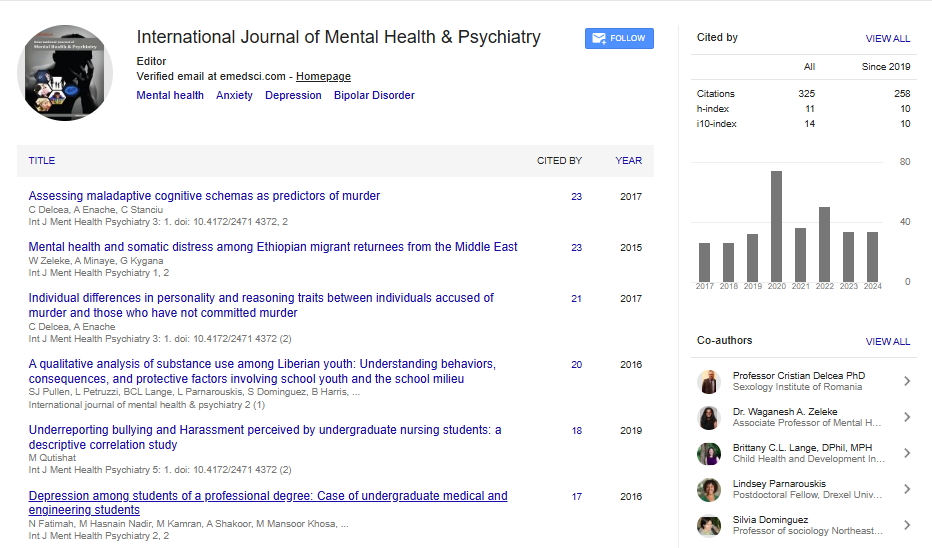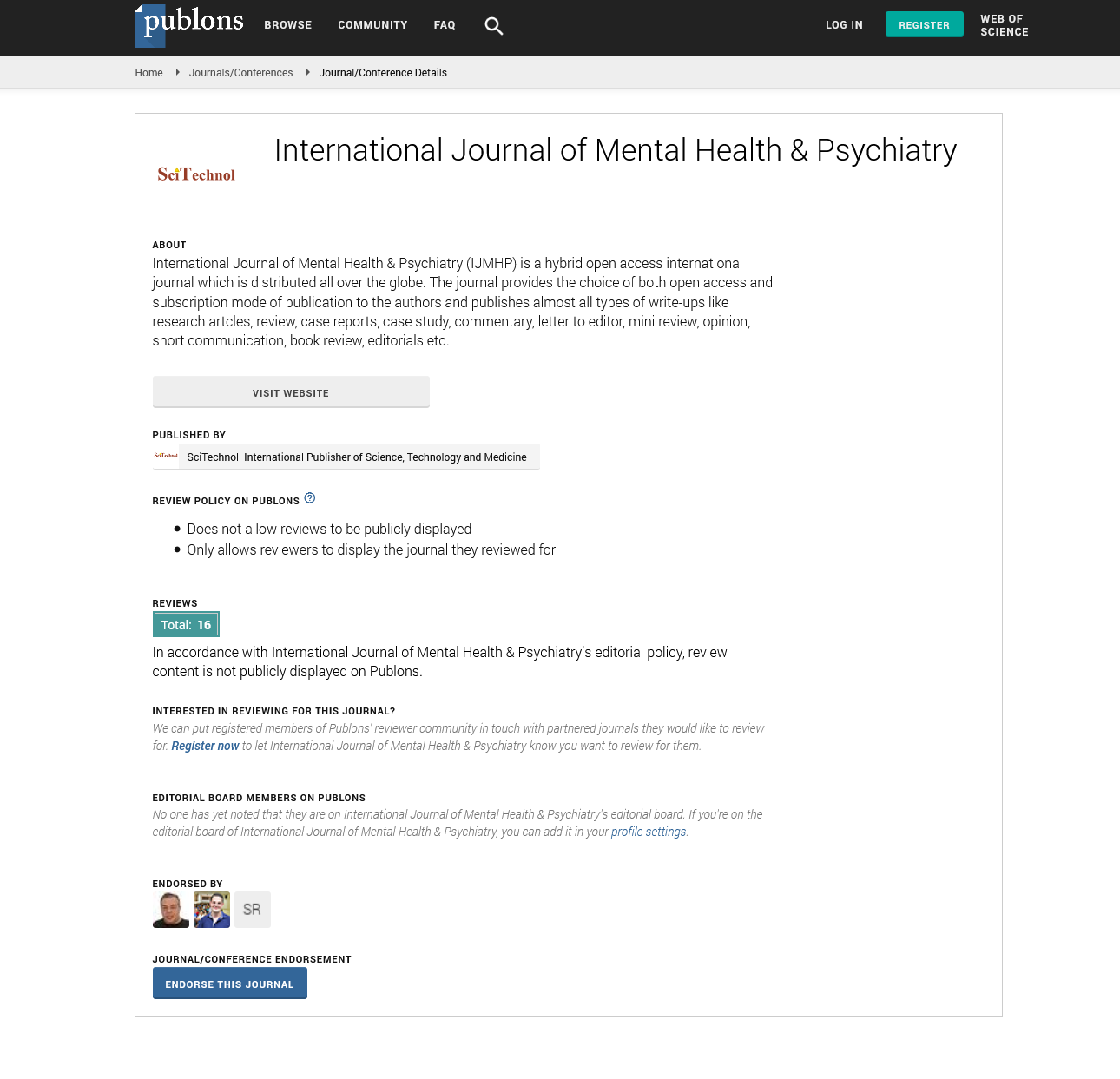Opinion Article, Int J Ment Health Psychiatry Vol: 10 Issue: 4
The Role of Creative Arts in Psychotherapy: Bridging Emotions and Healing
Pedro Gonzalez*
1Department of Psychiatry, Heidelberg University, Heidelberg, Germany
*Corresponding Author: Pedro Gonzalez,
Department of Psychiatry, Heidelberg
University, Heidelberg, Germany
E-mail: gonzalezp48@gmail.com
Received date: 26 November, 2024, Manuscript No. IJMHP-24-154323;
Editor assigned date: 28 November, 2024, PreQC No. IJMHP-24-154323 (PQ);
Reviewed date: 12 December, 2024, QC No. IJMHP-24-154323;
Revised date: 20 December, 2024, Manuscript No. IJMHP-24-154323 (R);
Published date: 27 December, 2024, DOI: 10.4172/2471-4372.1000281
Citation: Gonzalez P (2024) The Role of Creative Arts in Psychotherapy: Bridging Emotions and Healing. Int J Ment Health Psychiatry 10:4.
Description
The integration of creative arts into psychotherapy has emerged as a transformative approach to mental health care, offering innovative methods to adoptive emotional expression, personal insight and psychological healing. By exploiting visual arts, music, drama, dance and other creative mediums, this therapeutic model has proven effective in addressing a wide range of psychological challenges. Innovative arts in psychotherapy provide individuals with a safe and supportive environment to express feelings that may be difficult to verbalize. For many, traditional talk therapy can feel intimidating or insufficient, especially when words cannot fully encapsulate their experiences. Artistic expression transcends linguistic barriers, enabling clients to explore complex emotions, memories and trauma in a nonverbal yet deeply personal manner.
Art therapy encourages individuals to engage with painting, drawing, or sculpting as a way to externalize internal conflicts. The process, rather than the final product, is emphasized, allowing clients to reflect on their creations and uncover underlying emotions. This approach has shown significant benefits for individuals dealing with trauma, grief, or anxiety. Music therapy connects the power of rhythm, melody and sound to connect with emotions. Whether listening to soothing compositions, creating music, or singing, clients can experience reduced stress, improved mood and a sense of accomplishment. This modality is particularly effective in managing conditions such as depression, PTSD and autism spectrum disorders.
Drama therapy utilizes role-playing, storytelling and improvisation to help clients explore relationships, fears and unresolved conflicts. By stepping into various roles, individuals can gain new perspectives on their challenges and practice problem-solving in a safe, controlled setting. This form of therapy emphasizes the connection between mind and body. Movement becomes a medium for expressing suppressed emotions, enhancing body awareness and promotion a sense of empowerment. It is particularly beneficial for individuals experiencing trauma, eating disorders, or chronic pain.
Writing provides a structured way for individuals to process thoughts and emotions. Through journaling, poetry, or storytelling, clients can articulate their inner experiences, promotion insight and emotional release. Creative arts therapy promotes emotional spirit and psychological growth. The nonjudgmental and exploratory nature of the arts allows individuals to probe into their subconscious, facilitating self-discovery and acceptance. It also offers a therapeutic outlet for managing stress, anxiety and depression by channeling negative emotions into creative pursuits.
The arts encourage mindfulness, as engaging with a creative task often requires complete focus on the present moment. This meditative quality helps clients detach from rumination and adopts relaxation. Additionally, the sensory experience of art, music, or movement stimulates the brain’s reward system, releasing dopamine and enhancing overall well-being. Beyond individual benefits, arts-based therapy can strengthen interpersonal relationships. Group art therapy sessions foster collaboration, empathy and mutual support, particularly in settings like family therapy or community programs. For clients with social anxiety or difficulty in verbal communication, participating in group creative activities can ease interactions and build confidence.
Creative arts therapy continues to gain recognition across diverse clinical settings. Schools, hospitals, rehabilitation centers and psychiatric clinics increasingly incorporate this approach into their programs. Research supports its efficacy in improving the quality of life for individuals with chronic illnesses, developmental disorders and mental health conditions. As society grows more attuned to complete health models, the demand for trained art therapists is also rising. Professionals in this field must possess a strong foundation in both psychology and the arts, ensuring they can tailor interventions to each client’s unique needs.
Conclusion
The integration of creative arts in psychotherapy represents a reflective shift toward a more complete approach to mental health care. By providing alternative pathways for emotional expression and healing, this approach empowers individuals to reconnect with their inner selves, cultivate spirit and board on journeys of personal transformation. Through art, the silent becomes audible, the unseen becomes visible and the fragmented finds unity.
 Spanish
Spanish  Chinese
Chinese  Russian
Russian  German
German  French
French  Japanese
Japanese  Portuguese
Portuguese  Hindi
Hindi 
